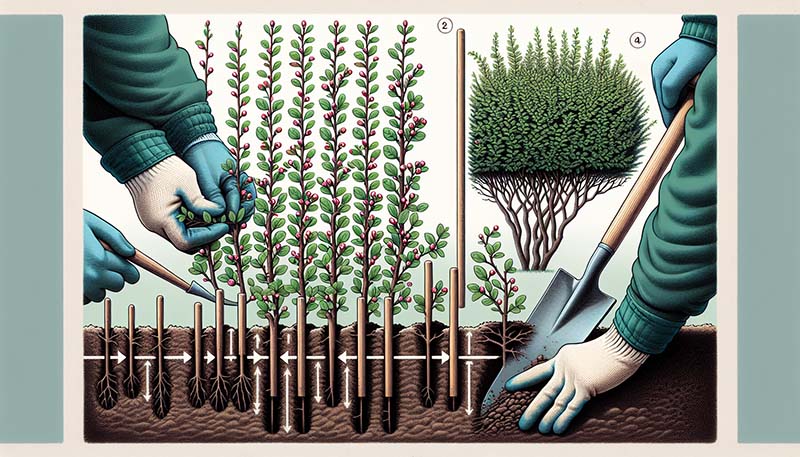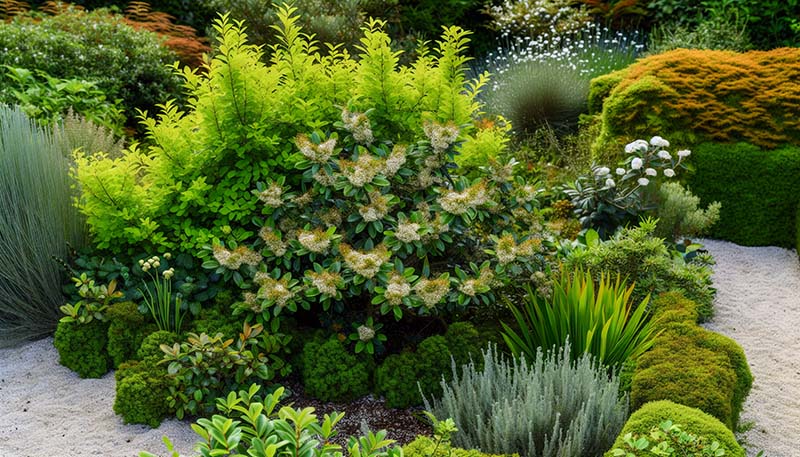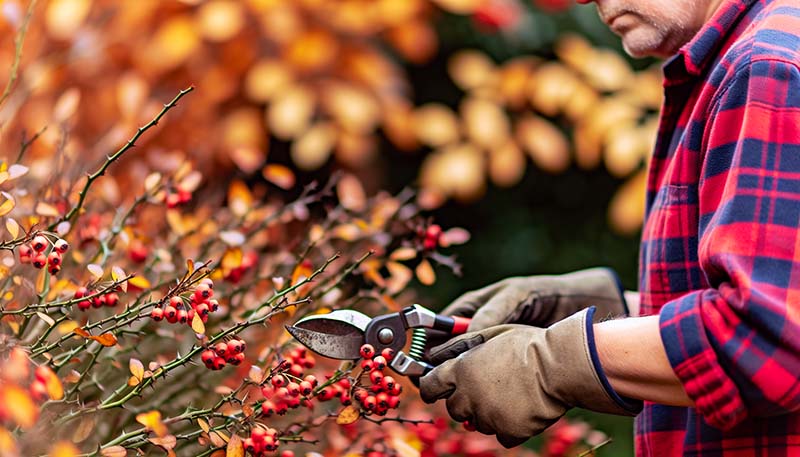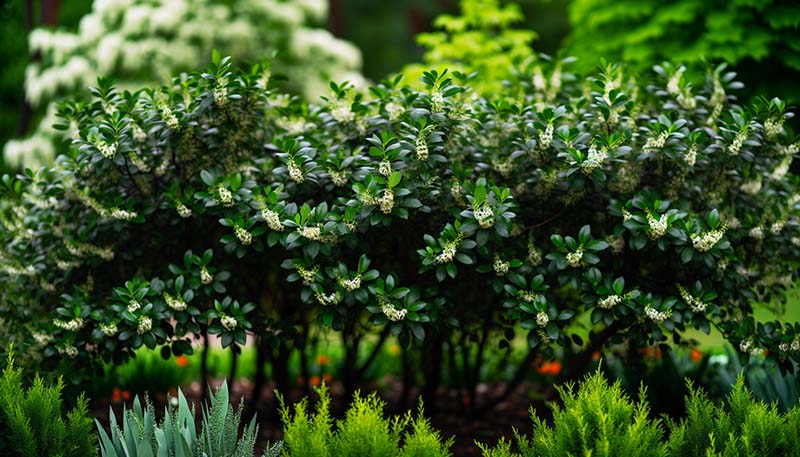Imagine a garden graced with the rustic charm of a native whitethorn hedge, alive with birdsong and the hum of pollinators, and bearing the seasons’ gifts of fragrant blossoms and vibrant berries. Whitethorn hedges, a timeless fixture of Irish landscapes, offer this enchanting tableau and more.
Key Takeaways
- Whitethorn hedging plants offer a range of practical benefits with their rapid growth, thorns and seasonal blooms & fruits.
- Mastering Whitethorn Hedge Planting Techniques involves selecting quality bare root plants, using the staggered double row planting method and effective mulching & weed prevention strategies.
- Supporting local ecosystems, Whitethorn provides habitat for wildlife while also enhancing landscape aesthetics with its spring blooms & autumn berries.
The Allure of Whitethorn Hedging: A Natural Wonder
Whitethorn hedges, also known as hawthorn hedges, hold a bewitching allure. Their features include:
- Rapid growth
- Thorny demeanor
- Dark glossy green leaves
- Clusters of scented white flowers in spring
- Glossy red haws in autumn
These qualities make them a practical choice for garden borders and farm fields alike, while also providing natural beauty and attracting wildlife.
An economically attractive choice, whitethorn hedging plants are a testament to nature’s generosity. They offer the following benefits:
- Tolerate wet soils
- Offer dense cover
- Bloom profusely from spring to early summer
- The fragrant white flowers draw bees and other pollinators
- The red berries offer a reliable food source for birds and small animals in the fall.
Growth Patterns and Maintenance Tips
The vigor with which Whitethorn hedges grow is truly remarkable. They can reach a height of 7-8 meters at a growth rate of 18-36 inches per year. This fast growth, coupled with their ability to thrive in different soil types and conditions, makes them a popular choice for quick and effective hedging. Buy Whitethorn Plants here
Remarkable for their robust growth, Whitethorn hedges are also low maintenance and only require occasional pruning to maintain their shape and stimulate fresh growth. The first two years are crucial for the hedge’s development. After that, the hedge should be pruned during the winter months when it is dormant, promoting a thicker and healthier growth.
Soil Compatibility and Planting Advice
Whitethorn’s adaptability stands out among its many merits. These hardy hedges can accommodate a wide range of soil types, from sandy to clay, and thrive in both sunny and lightly shaded areas. This versatility makes them a fitting choice for various landscapes.
When planting Whitethorn hedges, careful preparation is necessary. Here are the steps to follow:
- Clear the soil of overgrown vegetation.
- Dig a hole deep enough to accommodate the Whitethorn’s roots.
- Add compost to nourish the soil and promote healthy growth.
- Plant the Whitethorn hedge from October to March, when it is dormant.
Enhancing Wildlife Habitats with Whitethorn
Whitethorn hedges, while aesthetically pleasing, also play a significant role in supporting local ecosystems. They provide a rich habitat for a variety of wildlife, including:
- Birds
- Bees
- Butterflies
- Small mammals like hedgehogs and bats
The dense foliage of the Whitethorn hedges offers shelter to these creatures, while the flowers and berries serve as a valuable food source. Additionally, a specimen tree can enhance the overall aesthetic of the landscape.
These hedges also have a profound impact on the sustainability of wildlife habitats. They:
- Act as a physical barrier to impede pollution
- Provide pathways for wildlife
- The spring bloom of their white scented flowers draws in bees and other pollinators
- The red berries that appear in autumn offer a reliable food source for birds.
Mastering Whitethorn Hedge Planting Techniques

With the right techniques and some practice, the art of planting a Whitethorn hedge can be mastered. From the selection of quality bare root plants to the implementation of effective planting methods and mulching techniques, each step plays a crucial role in the successful establishment of a Whitethorn hedge.
The staggered double row planting method is highly recommended for Whitethorn hedges. This method involves planting the hedges in two rows, with each plant placed at a distance that allows ample space for growth and results in a dense, bushy hedge. Pair this method with effective mulching and weed prevention strategies, and you have a recipe for a thriving, healthy hedge.
Selecting Quality Bare Root Plants

Selecting quality bare root plants is the first step towards planting a successful Whitethorn hedge. These plants should have a healthy root mass to facilitate better absorption of essential nutrients and minerals, especially in very wet soil conditions.
When selecting the optimum bare root Whitethorn plant, it’s essential to:
- Choose from a reliable vendor
- Look for plants with well-developed root systems and vigorous foliage
- Consider the plant’s age and size, as they play a crucial role in its survival and growth after planting.
The Staggered Double Row Planting Method
For a dense and aesthetically appealing hedge, the staggered double row planting method is ideal. This technique involves planting in two rows, with a distance of approximately 330mm (just over a foot) between the rows and the same distance between the plants within the rows.
By positioning the plants in close proximity, the staggered double row method promotes denser and bushier growth, resulting in a thick and robust hedge with a dense crown. This planting method is particularly beneficial for Whitethorn hedges, enhancing their natural beauty and practical functionality.
Mulching and Weed Prevention Strategies
Establishing and maintaining a healthy Whitethorn hedge hinges on effective mulching and weed prevention strategies. Mulching aids in weed control, helps to retain soil moisture, regulates soil temperature, and facilitates the settling in of the hedge after planting.
To prevent weed growth, it’s recommended to cover the soil around the hedge with a layer of mulch, preferably grass clippings, wood chips, or bark mulch. Regular replacement of the mulch, typically on an annual basis, ensures the continued health and growth of the Whitethorn hedge.
Integrating Whitethorn With Other Native Hedging Plants

While Whitethorn hedges are beautiful on their own, pairing them with other native hedging plants introduces a new level of visual appeal and ecological benefits to a garden. This integration fosters biodiversity by providing a diverse habitat for wildlife.
The synergy between whitethorn plants and other native hedging plants forms a rich tapestry of colors, textures, and growth habits, creating a vibrant and resilient hedgerow. Some examples of plants that complement Whitethorn are:
- Blackthorn, with its silvery leaves
- Dog Rose, with its bright red hips
- Hazel, with its vibrant foliage
- Elder, with its white flowers
Each plant enhances the overall visual appeal and ecological function of the hedge.
Complementary Native Species
Selecting compatible native species is paramount in a mixed hedge. Plants such as:
- Blackthorn
- Dog Rose
- Hazel
- Elder
- Holly
not only harmonize with the Whitethorn visually, but they also share similar growth patterns and habitat preferences, ensuring a balanced and thriving hedgerow.
Each of these native species contributes to the hedge’s overall health and resilience, fulfilling specific roles in capturing energy, unlocking nutrients, and supporting a diverse range of flora and fauna. Their varied bloom times and colors add to the seasonal interest, making the hedgerow a year-round spectacle.
Designing a Mixed Hedge
Designing a mixed hedge offers a creative outlet to showcase your unique gardening style and contribute to local biodiversity. The choice of plants, their arrangement, and the spatial design all play a crucial role in creating a visually appealing and ecologically beneficial hedgerow.
When planning a mixed hedge, consider factors such as the height and spread of the plants, their tolerance to trimming, and their visual appeal in different seasons. Paying attention to these details will ensure that your mixed hedge not only looks great but also supports a diverse range of wildlife.
Benefits of Diversity in Hedging
Diversity in hedging extends beyond visual appeal; it’s an ecological necessity. A diverse hedge offers a range of habitats and food sources for wildlife, encourages pollinators, and maintains a balanced ecosystem.
Moreover, a diverse foraging hedge is more resilient to pests, diseases, and environmental stresses. Each plant species performs a specific role in capturing energy and unlocking nutrients, which benefits the soil and overall ecosystem health. The result is a thriving hedge that not only enhances your garden’s beauty but also contributes significantly to local biodiversity.
Seasonal Care for Your Whitethorn Hedge
Similar to other garden plants, Whitethorn hedges need seasonal care to ensure their optimal growth and health. From spring awakening to summer growth monitoring and autumn preparations, each season brings its unique needs and tasks.
Regular watering during dry spells, pruning to promote healthy growth, and removing dead or damaged branches are some of the measures that ensure your Whitethorn hedge thrives throughout the summer. As autumn approaches, preparing your hedge for the upcoming winter is crucial. This includes pruning to encourage new growth and harvesting the ripe red berries.
Spring Awakening: Initial Buds and Flowers
Like all of nature, Whitethorn hedges also experience a time of renewal and awakening in spring. As the days grow longer and warmer, the hedges come alive with the emergence of buds and the blooming of prominent scented white flowers.
This burst of growth signals the start of the growing season and provides a visual feast for garden lovers. It’s also the ideal time to apply a slow-release fertilizer to support the plant’s growth and prepare for the fruitful seasons ahead.
Summer Vigilance: Growth and Health Monitoring
Your Whitethorn hedge will experience a flurry of growth and activity during the summer. It’s a crucial period to monitor the health of your hedge closely and take proactive measures to maintain its vitality.
Regular watering during dry spells, pruning to promote healthy growth, and keeping an eye out for common diseases and pests are essential care steps during this season. Regular maintenance, such as trimming and assessing the overall condition of the hedge, can provide insights into its nutrient needs and help you plan for the seasons ahead.
Autumn Preparations: Pruning and Berry Harvest

When the vibrant hues of autumn transform the landscape, it signals the time to get your Whitethorn hedge ready for winter. This involves pruning the hedge and harvesting the ripe, glossy red berries.
Autumn is an ideal time for pruning. It involves removing any dead, diseased, or dying growth and thinning out any overcrowded branches. The harvested berries, apart from their various applications, are a testament to the bounty of nature that Whitethorn hedges offer.
The Role of Whitethorn Hedges in Irish Farm Fields and Beyond
The rich historical significance of Whitethorn hedges goes beyond their aesthetic appeal. Used traditionally in Irish farm fields as natural boundaries, they have evolved to find relevance in contemporary garden design and landscape planning.
Nowadays, Whitethorn hedges are valued for more than just their rustic charm; their versatility is also highly appreciated. They can be adapted to suit different garden styles and purposes, from traditional cottage gardens to contemporary minimalist settings, proving their timeless appeal and multifaceted benefits.
Historical Significance and Modern Applications
Whitethorn hedges have been a part of the Irish landscape for centuries, serving practical purposes in farm fields and holding spiritual significance. Farmers used the thorny hedges as natural fences to enclose their land and livestock, while the red berries were used for making jams and jellies, and also provided sustenance for birds.
In contemporary times, Whitethorn hedges have found their place in landscape design and gardening. They serve as effective intruder barriers in gardens and offer shelter and shade for livestock in agricultural settings. Their adaptability to various garden styles and purposes is a testament to their timeless appeal and practicality.
Adapting Whitethorn for Different Garden Styles
Versatility is a key aspect of the beauty of Whitethorn hedges. They can be pruned into precise, geometric shapes for a Japanese garden style or allowed to grow naturally for a rustic English cottage garden look.
In a rock garden, the dense foliage and sharp thorns of the Whitethorn hedge provide a natural border that complements the rocky terrain. The white flowers and red berries add a splash of color and visual interest to the garden.
Supporting Local Ecosystems with Native Deciduous Plants
Incorporating native deciduous plants like Whitethorn in your garden has several benefits:
- Enhances the beauty of your garden
- Bolsters the wellbeing of local ecosystems
- Provides a habitat and food sources for various species
- Plays a crucial role in maintaining local biodiversity
Moreover, Whitethorn hedges offer:
- Nesting sites and shelter for birds and other animals
- The spring bloom of white scented flowers that draw in bees and other pollinators
- Red berries in autumn that offer a reliable food source for birds.
Summary
Whitethorn hedges are more than just a pretty addition to your garden. They are a symbol of rich historical significance, a practical solution for boundary marking, and a haven for wildlife. From their captivating spring blooms to their glossy red berries in autumn, their aesthetic appeal is undeniable.
But beyond their beauty, Whitethorn hedges offer a wealth of benefits. They support local ecosystems, enhance soil health, and provide habitats for a variety of species. Whether you’re designing a traditional cottage garden, a contemporary minimalist garden, or a rustic rock garden, Whitethorn hedges prove to be a timeless and versatile choice.
Frequently Asked Questions
Is Whitethorn a good hedge?
Whitethorn hedging plants are hardy and fast-growing, making them a great choice for border or stock-proof hedges. Their fragrant white flowers during the spring/summer period make them even more attractive. Overall, Whitethorn is an excellent hedge.
How long does it take for a Whitethorn hedge to grow?
A Whitethorn hedge typically takes two years to reach its full growth potential, with a rate of 18-36 inches per year. It should then be trimmed during the winter months to allow it to thicken up.
Is Whitethorn an evergreen?
Whitethorn Hedging is a deciduous shrub or tree, so it is not an evergreen.
What are the benefits of the hawthorn hedge?
Hawthorn hedging is a great way to deter intruders and provide wind protection in both summer and winter. Its dense branches make for an effective cover from the elements.
What is Whitethorn?
Whitethorn, or hawthorn, is a popular deciduous hedging plant that grows quickly and provides a thorny barrier for gardens. It is native to many areas across the globe.

